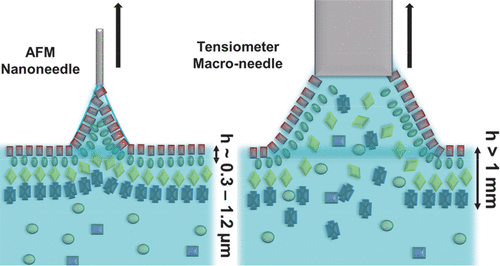Our official English website, www.x-mol.net, welcomes your
feedback! (Note: you will need to create a separate account there.)
Surface Tension Measurements of Aqueous Liquid–Air Interfaces Probed with Microscopic Indentation
Langmuir ( IF 3.7 ) Pub Date : 2021-02-12 , DOI: 10.1021/acs.langmuir.0c03507 Chathuri P. Kaluarachchi 1 , Hansol D. Lee 1 , Yiling Lan 1 , Thiranjeewa I. Lansakara 1 , Alexei V. Tivanski 1
Langmuir ( IF 3.7 ) Pub Date : 2021-02-12 , DOI: 10.1021/acs.langmuir.0c03507 Chathuri P. Kaluarachchi 1 , Hansol D. Lee 1 , Yiling Lan 1 , Thiranjeewa I. Lansakara 1 , Alexei V. Tivanski 1
Affiliation

|
To elucidate the intricate role that the sea surface microlayer (SML) and sea spray aerosols (SSAs) play in climate, understanding the chemical complexity of the SML and how it affects the physical–chemical properties of the microlayer and SSA are important to investigate. While the surface tension of the SML has been studied previously using conventional experimental tools, accurate measurements must be localized to the thickness of the air–liquid interface of the SML. Here we explore the atomic force microscopy (AFM) capabilities to quantify the surface tension of aqueous solution droplets with (sub)micrometer indentation depths into the interface. Sample droplets of hexanoic acid at molar concentrations ranging from 0.1 to 80 mM and SML from a recent wave flume study were investigated. A constant-radius AFM nanoneedle was used to probe ca. 200 μL droplets with 0.3–1.2 μm indentation depths. As a comparison, the surface tension of bulk samples was also measured using a conventional force tensiometer. The data for the hexanoic acid show an excellent overlap between the AFM and force tensiometer surface tension measurements. For the surface tension measurements of the SML, however, the measured values from the AFM were 2.5 mN/m lower than that from the force tensiometer, which was attributed to the structural and chemical complexity of the SML, differences in the probing depth for each method, and the time scale required for the surface film to restructure as the needle is retracted away from the liquid surface. Overall, the study confirmed the accuracy of the AFM method in quantifying the surface tension of aqueous solutions over a wide range of concentrations for surface-active organic compounds. The methodology can be further used to reveal small, yet important, differences in the surface tension of complex air–liquid interfaces such as liquid systems where the type and concentration of surfactants vary with the distance from the air–liquid interface. For such complex systems, AFM measurements of the surface tension as a function of the probing depth and pulling rate may reveal a sublayer film structure of the liquid interface.
中文翻译:

用微观压痕探测液态-空气界面的表面张力测量
为了阐明海面微层(SML)和海浪气溶胶(SSA)在气候中所起的复杂作用,了解SML的化学复杂性及其对微层和SSA的物理化学性质的影响非常重要。尽管先前已使用常规实验工具研究了SML的表面张力,但必须将精确的测量值定位在SML气液界面的厚度上。在这里,我们探索原子力显微镜(AFM)的功能,以量化具有(亚)微米压痕深度进入界面的水溶液液滴的表面张力。最近的波浪水槽研究中,研究了摩尔浓度范围为0.1至80 mM的己酸样品滴和SML。恒定半径的AFM纳米针用于探测ca。200μL液滴,压痕深度为0.3–1.2μm。作为比较,还使用常规力张力计测量了大块样品的表面张力。己酸的数据显示了AFM和力张力计表面张力测量之间的出色重叠。然而,对于SML的表面张力测量,AFM的测量值比力张力计的测量值低2.5 mN / m,这归因于SML的结构和化学复杂性,每种探测深度的差异的方法,以及当针头从液体表面缩回时表面膜重构所需的时间刻度。全面的,这项研究证实了AFM方法在定量测定各种表面活性有机化合物浓度范围内的水溶液表面张力时的准确性。该方法可进一步用于揭示复杂气液界面(如液体系统)表面张力的微小但重要的差异,其中表面活性剂的类型和浓度随距气液界面的距离而变化。对于这种复杂的系统,AFM测量的表面张力是探测深度和拉动速率的函数,可能会显示出液体界面的亚层膜结构。复杂气液界面的表面张力的差异,例如液体系统,其中表面活性剂的类型和浓度随距气液界面的距离而变化。对于这种复杂的系统,AFM测量的表面张力是探测深度和拉动速率的函数,可能会显示出液体界面的亚层膜结构。复杂气液界面的表面张力的差异,例如液体系统,其中表面活性剂的类型和浓度随距气液界面的距离而变化。对于这种复杂的系统,AFM测量的表面张力是探测深度和拉动速率的函数,可能会显示出液体界面的亚层膜结构。
更新日期:2021-02-23
中文翻译:

用微观压痕探测液态-空气界面的表面张力测量
为了阐明海面微层(SML)和海浪气溶胶(SSA)在气候中所起的复杂作用,了解SML的化学复杂性及其对微层和SSA的物理化学性质的影响非常重要。尽管先前已使用常规实验工具研究了SML的表面张力,但必须将精确的测量值定位在SML气液界面的厚度上。在这里,我们探索原子力显微镜(AFM)的功能,以量化具有(亚)微米压痕深度进入界面的水溶液液滴的表面张力。最近的波浪水槽研究中,研究了摩尔浓度范围为0.1至80 mM的己酸样品滴和SML。恒定半径的AFM纳米针用于探测ca。200μL液滴,压痕深度为0.3–1.2μm。作为比较,还使用常规力张力计测量了大块样品的表面张力。己酸的数据显示了AFM和力张力计表面张力测量之间的出色重叠。然而,对于SML的表面张力测量,AFM的测量值比力张力计的测量值低2.5 mN / m,这归因于SML的结构和化学复杂性,每种探测深度的差异的方法,以及当针头从液体表面缩回时表面膜重构所需的时间刻度。全面的,这项研究证实了AFM方法在定量测定各种表面活性有机化合物浓度范围内的水溶液表面张力时的准确性。该方法可进一步用于揭示复杂气液界面(如液体系统)表面张力的微小但重要的差异,其中表面活性剂的类型和浓度随距气液界面的距离而变化。对于这种复杂的系统,AFM测量的表面张力是探测深度和拉动速率的函数,可能会显示出液体界面的亚层膜结构。复杂气液界面的表面张力的差异,例如液体系统,其中表面活性剂的类型和浓度随距气液界面的距离而变化。对于这种复杂的系统,AFM测量的表面张力是探测深度和拉动速率的函数,可能会显示出液体界面的亚层膜结构。复杂气液界面的表面张力的差异,例如液体系统,其中表面活性剂的类型和浓度随距气液界面的距离而变化。对于这种复杂的系统,AFM测量的表面张力是探测深度和拉动速率的函数,可能会显示出液体界面的亚层膜结构。











































 京公网安备 11010802027423号
京公网安备 11010802027423号